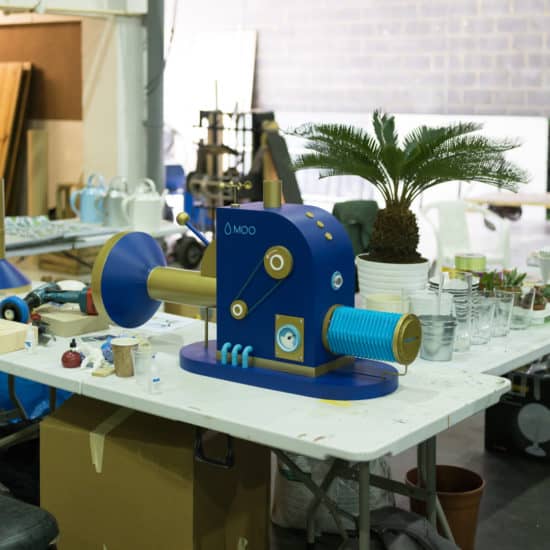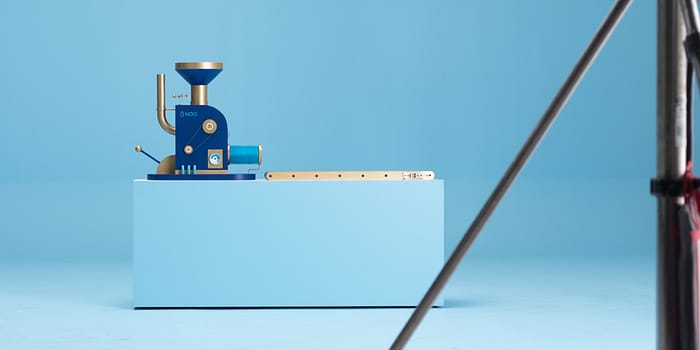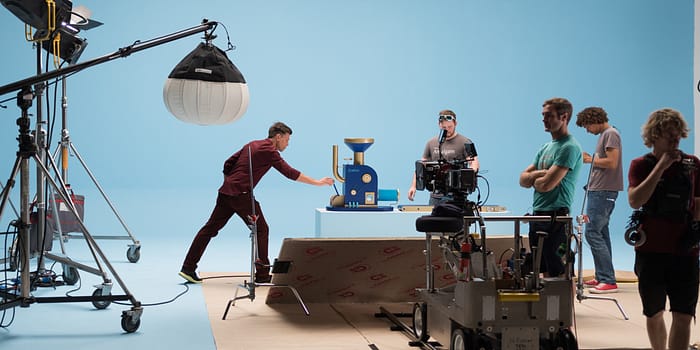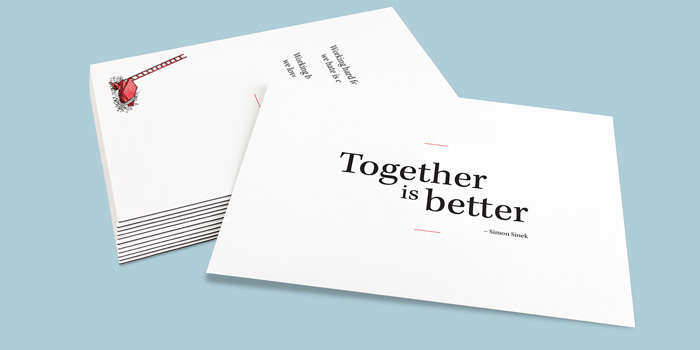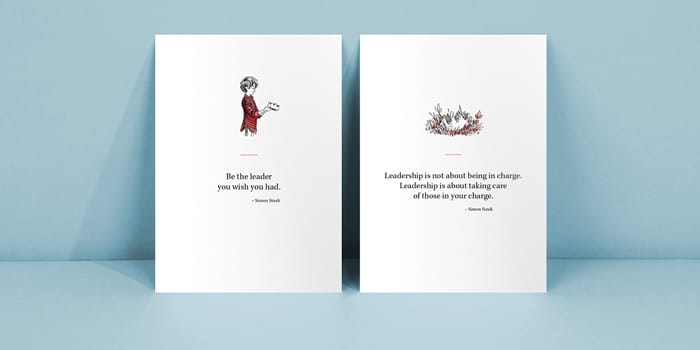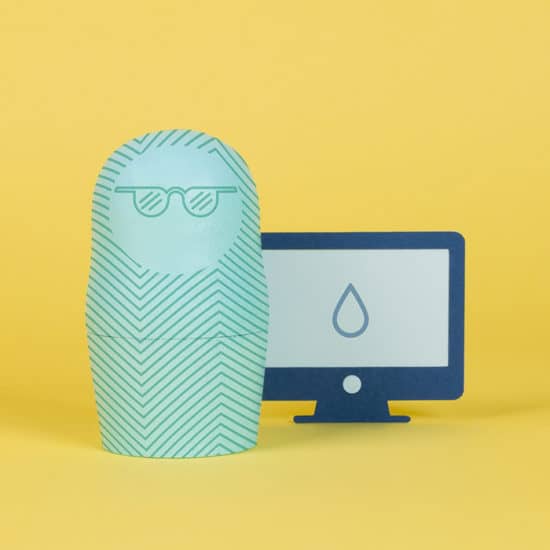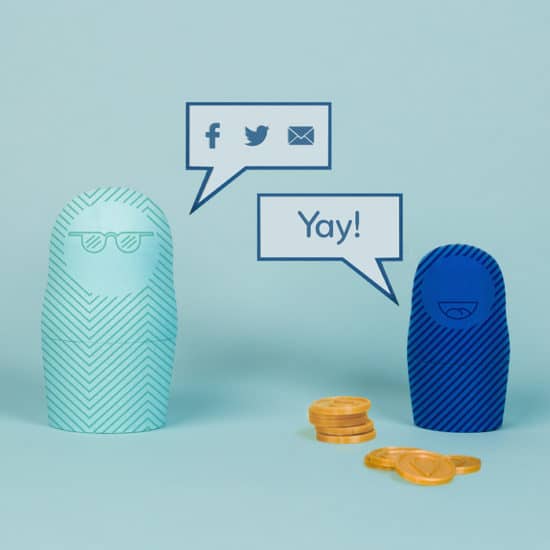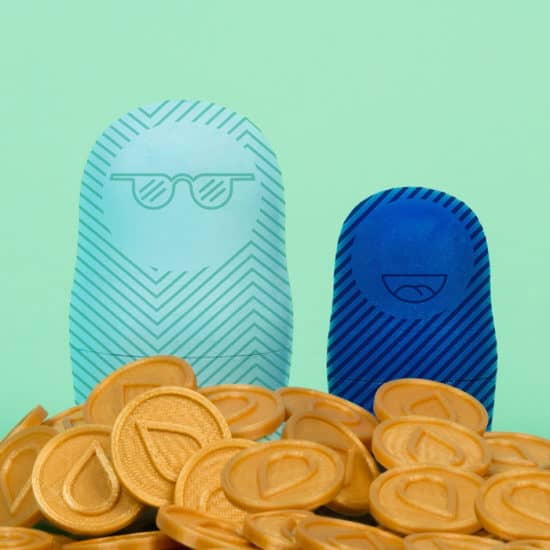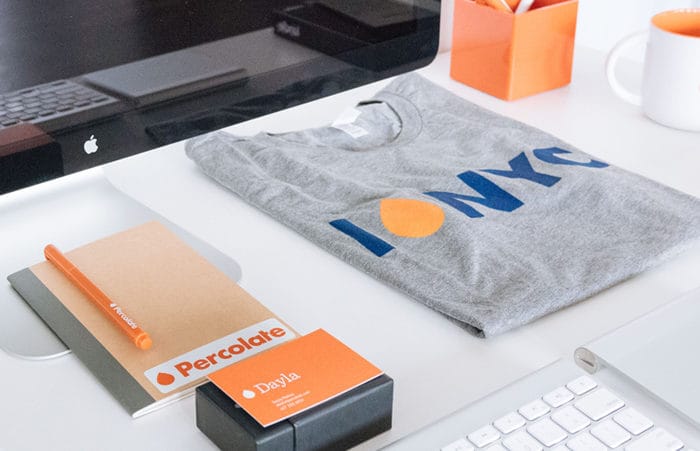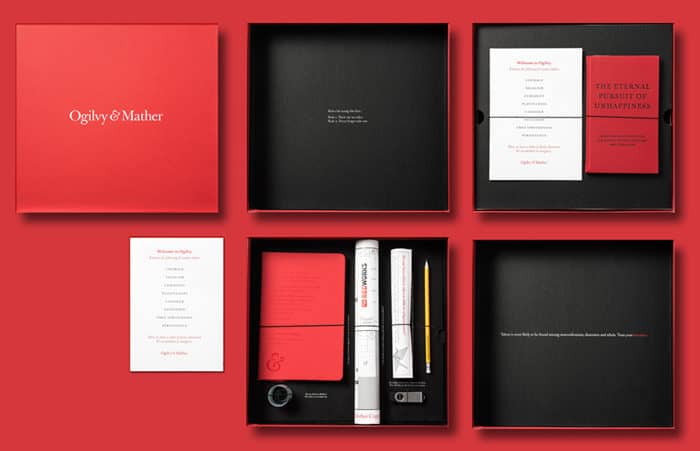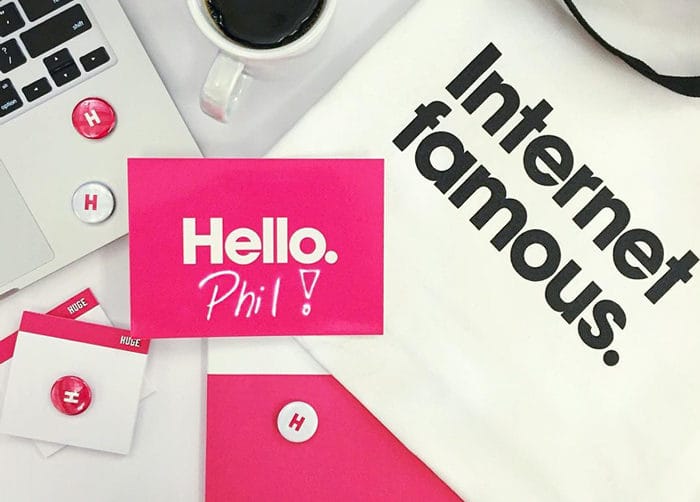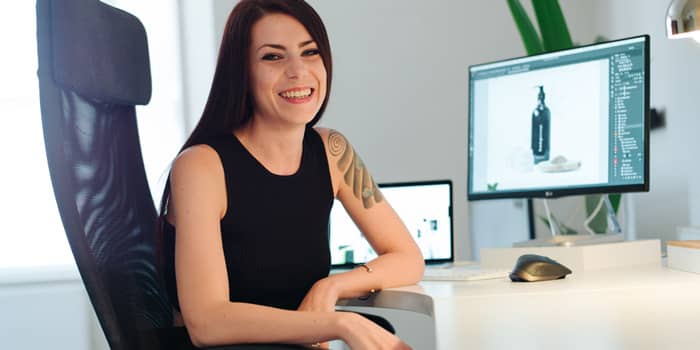We’ve fallen for this Australian creative studio
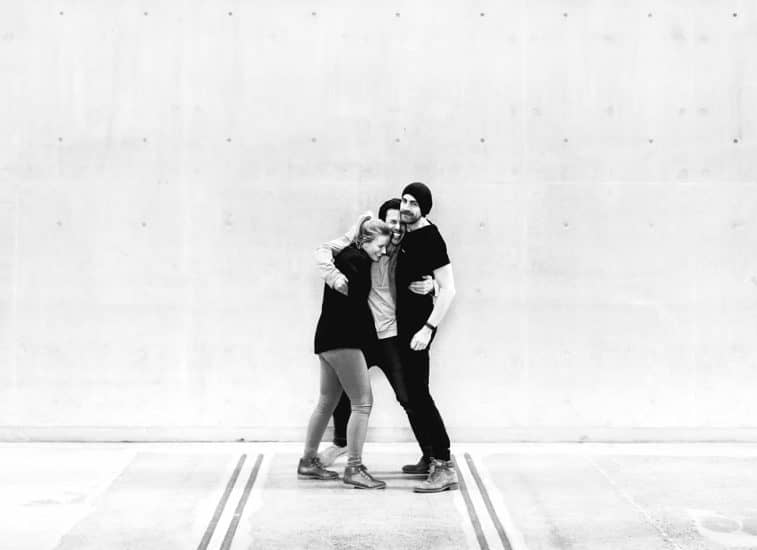
Autumn. is a multi-disciplinary creative studio based in Brisbane. Run by a friendly team of designers, photographers, strategists and developers, they have created installations for some of our Australian events. We met its founder Paul Mckie and talked about design, business development and the creative process.
Why did you set up the agency?
Our ambition from the very start was to help build memorable brands that evoke meaning and inspire interactions. That’s a great motivator for me. I believe that good design can really change things for a business so we develop ideas that enable visual change and growth for both brand and business.
What’s your advice for other agencies looking to develop their client base?
If you see a brand/company that you would like to do work for/with, don’t be afraid to simply send an email to say ‘hi’ and introduce yourself. We also try to get involved with our industry as much as possible, but also that of our clients. This opens you up to a lot of possibilities for not only client work, but great opportunities to collaborate with other creatives.
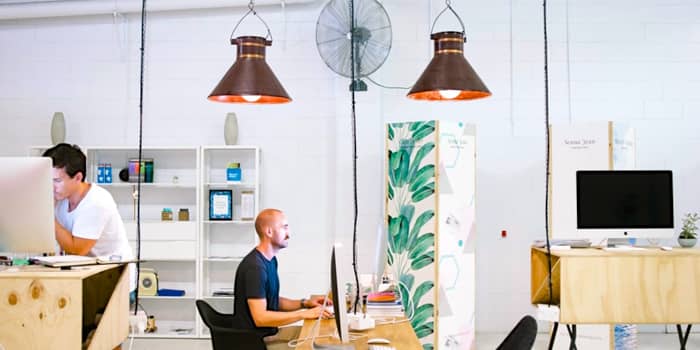
You recently helped MOO stand out at Semi-Permanent, what did you create?
For this year’s Semi-Permanent event we created over-sized Postcards and teamed them with matching MOO display cases. The great thing about the postcards was that a diverse range of artists, typographers and designers supplied the artwork. Conferences like SP attract a bunch of like-minded creatives and entrepreneurs, therefore the product or services that are showcased at this particular event are relevant to the need of that demographic—increasing brand awareness. This goes for all industries.
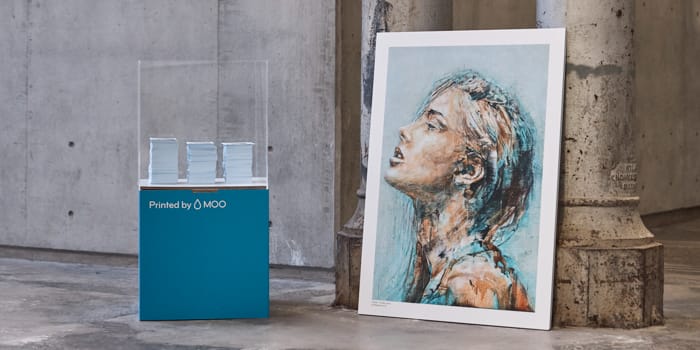
You have had quite a bit to do with Shillington College, why?
We all have someone that showed us a thing or two, invested time into our careers or simple gave us some solid advice. It’s our responsibility to send the love back down the chain and let the knowledge flow through us and to others. You risk becoming stagnant yourself if you’re not freely imparting. The entire process is also incredibly rewarding and involving yourself with fresh creative perspectives is very inspiring!
What do you tell the next generation of graduates to get them ready for a design-led career?
A creative studio will employ people not portfolios. So make sure you invest as much time on finding what defines ‘you’ as well as that of your portfolio. Your chances of employment dramatically increase when you are skilled, self aware and most importantly happy and healthy. Also, immerse yourself in the industry, live and breathe your craft — be it through side projects or volunteering your time.
Sandra Blanco is an artist and entrepreneur who produces bridal headpieces made from preserved – or ‘everlasting’ flowers. Her Sophie and Luna brand bloomed in a Clapham living room two years and she now sells them through Etsy and Not On The High Street to customers across the world.
Tell us a bit about your story.
I’m originally from Spain, and came to London for what I thought would be just one year in 2009. After falling in love with the city, I stayed to do do an undergrad program. After that I began working in fashion and marketing. I was always artistic when I was younger; I’ve always loved to create and draw things.
Why did you start your business?
I always refer to it as “the most beautiful accident”. I lost my job in marketing and being three months away from my wedding, I threw myself into planning it. I got frustrated that the only flower crowns and bouquets available to me had such a short lifespan, so I made my own with dried flowers for myself and my bridesmaids. I had some amazing feedback and people began encouraging me to start selling the crowns I was making. The opportunity was there in front of me so I decided to give it a go!
What do you promote and grow your business?
I began with selling at a local craft festival – I sold over 40 crowns in just four hours that day, whilst giving away MiniCards which I’d glued petals to. We of course have our online presence through our website and social media but I do the majority of my promotion at events, things such as fairs and festivals. I make sure I have enough Business Cards and Flyers on me as you never know who you’ll meet. We have open studio days during the summer, and brides are always welcome to book an appointment to come into the studio for a chat and to see some of my work.
Tell us your favourite story about your business.
I always make sure I can offer something unique and I go the extra mile to do it. I was sourcing flowers and found these stunning Japanese preserved roses. When I found out the company didn’t ship to Europe I was disappointed, but I turned to my friends. It turned out my friend was travelling in Asia so a few favors and a phone call later I convinced her to bring back an entire suitcase full of these flowers.
What’s the biggest thing you’ve learnt?
Use your networks and follow your passion. If you can offer something unique and are willing to put in enough hard work, you’ll receive great things.
Kyle Bean is the extraordinary young artist, designer and illustrator who transforms everyday materials into unexpected and witty objects. He worked alongside ad agency Mr. President to create the centrepiece of our latest campaign, The MOO Machine. We got him in for a chat about scoring amazing clients, his creative stimulation and the beautiful medium of paper.
You’ve worked on some incredible projects. What’s the key to getting commissioned?
It’s a nice niche that I find myself in, but to make it work in a commercial context has involved a lot of luck. I studied illustration at university, and at the private view of my degree show I met the visual merchandiser for Liberty, who really liked my work, and commissioned me for a collaboration with Hermès. That led me to work with other high-end fashion clients, and kind of gave me a seal of approval. Seven years down the line, I’ve got representation, but about half of my commissions still come to me direct.
How did you get into using ordinary materials like cardboard and paper?
I’m not ashamed to say that the reason I started using materials like paper was because it was relatively easy to use, and cheap, and I was a poor student. It’s kind of become my trademark, but it was originally a financial decision, combined with my passion for making things, that started me in that direction!
Do you find it easy to network and promote yourself?
I’ve had to work on it over the years but it doesn’t come that naturally. I still get a bit scared when I’m asked to give a talk somewhere. But I always feel like I benefit every time I do it. You learn the right things to say to sell yourself, build confidence, and improve for next time.
How does the creative process work for something like the MOO Machine?
The first thing to discuss with any client is what the key objective is. In this case, it was crafting a prop that communicated how MOO helps businesses express their personalities. With advertising-type jobs the initial idea usually comes from the client or agency, and MOO and Mr President had the concept of a machine that presses random elements of what makes them successful and turns them into delightful Business Cards and Postcards before coming to me, so developing the idea was quite straightforward.
What was different with this project was that I had to delegate the engineering to creative agency Blink Art, which was weird for me as I usually do everything from design to finished build. I can be a bit of a control freak – but I learned a lot about the importance of being a clear communicator from the early stages. As the collaboration worked so well on this project, it has given me thought for future projects to take this approach again. Being able to delegate is very important if you want to grow your business.
What are your future plans?
The thing that keeps me stimulated is diversity. I’m lucky that one minute I can be working on a stop-frame animation, the next I’m working on a big installation and the next I’ll do a series of illustrations for a magazine. I want to keep that mix, and stay autonomous and as excited about taking on the small projects as the big ones.
Biggest pearl of wisdom to pass on?
Take some time to think about your personal development and keep things fresh. If you’re always going from one big commercial job to another, that can be quite draining. As a creative individual you can start to feel quite lost. If I could go back in time, I would definitely tell my second-year university self to spend less time trying to develop a contrived way of working. Unless your work comes from passion it’s not going to be sustainable, and you’re not going to be fulfilled.
Watch our latest promo and see the machine in action!
https://youtu.be/aVxcnZ6BcQM
Have you been inspired by Kyle’s approach? Tell us in the comments below.
Written by: Katrina Vines
Growing businesses often outgrow their logo. That’s exactly why visual commerce platform and social media aficionados Olapic, chose to refresh theirs. Here’s how they did it.
Why rebrand?
“We pioneered an industry that helps brands put their consumers forth as effective brand ambassadors,” says Rachel Meranus, Chief Marketing Officer at Olapic. In six years, Olapic has gone from serving small and medium-sized e-commerce companies to global enterprise clients across different industries — and with that growth and the arrival of more competitors, Meranus and her team saw the need for a brand evolution.
“While our brand did a really good job reflecting who we were in the early days, it was time to put forth a new look, feel, and voice that was more professional and sophisticated in nature — a look that could hold its own with some of these major global brands that we’re currently working with,” she says. With the new brand, Olapic wanted to elevate its voice in the marketplace and focus on being the authority in all things visual content.
From old to new
The team selected New York-based branding consultancy Red Antler to handle the redesign. Meranus and her team were looking for an agency with experience in both business and consumer branding. While Olapic itself is a business to business brand, the companies they sell to are entirely consumer-focused, and they wanted that balance reflected in the new look.
Meranus’ marketing team was heavily involved in the design review and decision making process. “We don’t have anyone who owns our brand per se, but I’ve got a lot of very talented people on the team,” Meranus says. “I tapped into a lot of people in a lot of different ways — everyone from a lead designer to the woman who puts all of our big events together. The founders were also very involved from the get-go.”
The creative process
The agency-client relationship was a smooth one, with frequent check-ins and reviews. Eventually, the team settled on a look and feel based on a custom typeface that’s sophisticated, but with an edgy consumer feel. “It’s purposely black and white so that we can let the earned content that we’re collecting and curating for our clients stand out,” Mearnus says. “We really wanted to be viewed as the enabler and the platform that allows this all to happen.”
With the rebrand near completion, Meranus and her team started to talk about ways to bring the brand to life — most notably, the Olapic website. “The site plays two roles,” Meranus says. “One is thought leadership. We have a resource center where we’re putting forth ideas and educating the industry. But it’s also very much a lead generation site.” In addition to blog posts, the resource center features case studies and white papers that readers can access in exchange for their name and email. This provides the Olapic sales team with potentially interested leads to reach out to.
Getting employees onboard
While employees all knew that the rebrand was coming, Meranus and her team built excitement by working toward a big reveal with sneak peeks along the way. In the weeks leading up to the launch event, they teased out the new brand in Olapic’s weekly internal newsletter.
The day before the brand launch event, Olapic closed its offices for a redesign, installing big, bold, black and white statements on the walls of conference rooms and putting real user-generated imagery everywhere. The next day, employees walked into an entirely new office, where they saw the full brand system for the very first time. “To watch their reactions was just so gratifying,” Meranus says. “Everybody was in awe and wanted to take pictures in front of the new logo and brand statements. It was really incredible to see.”
Meranus then hosted a town hall meeting with the entire company, taking them through a truncated version of the whole process, including what the brand stands for, why they chose this look and feel, and what to expect in the future.
Unveiling the new look to the world
Olapic launched the website the week before Cannes Lions, the international festival of advertising and creativity. At the event itself, Olapic presented a reel with curated photos and videos generated by Cannes attendees. Activating its brand in this way not only showcased Olapic’s technology, but the new Olapic look and feel — and attendees were impressed. “Someone said to me at a party that it was the best activation they’d seen at Cannes,” Meranus says.
Consistency
The brand is consistently expressed across all of Olapic’s collateral, from press releases and trade show booths to the company’s social media accounts and employee Business cards. “The truth of the matter is that a Business card is a leave-behind — a conversation piece,” Meranus says. “If you do something cool, you have someone looking at your Business Card repeatedly. Our people are really excited about giving them out.”
All in all, Meranus and her team are delighted with the results. “The feedback has been really, really positive,” she says. “People love that the brand lets the content itself stand out, and that we are really leveraging user-generated content on our site and in our offices.” In other words, rebranding has been a great opportunity to show stakeholders just how a company has grown — and to stay on-brand through the evolution.
Are you looking to refresh your look? Share your experiences below.
Speaking with Simon Sinek isn’t an experience you forget quickly. His enthusiasm, his belief and his unstoppable optimism shine through every part of our conversation – it’s fast, free-flowing and fun.
We caught up with him to find out more about the ideas that make him tick, his collaboration with MOO and get his latest advice for surviving today’s busy workplace.
Together is better
Simon became widely known following his hugely popular TED talk, How Great Leaders Inspire Action. His distinctive approach – applying behavioural psychology and evolutionary thought to the modern workplace – was captured in his bestselling books Start With Why and Leaders Eat Last. Now, his new book Together is Better, takes a different tack.
Together is Better, challenges its readers to step outside our usual workplace behaviours. It explores cooperation, collaboration and leadership – but here’s the twist – it does so in the style of a fable. An illustrated storybook might not feel the most obvious way to talk about the workplace, but, argues Simon, that’s exactly why it’s a successful format here. “When we teach children,” he explains, “we teach with metaphors and analogies. Stories are more beautiful and the lessons easier to learn. “As adults, it’s really uncomfortable to talk about work and whether or not you’re really happy. To talk about it with a metaphor made it more disarming, and made more of us open to the message. I care more about the message than anything else.”
Safety to take risks
One of the subjects covered in the book is the importance of feeling safe at work. “Safety is a human requirement,” he elaborates. “At work, it’s the comfort to say ‘I don’t know what to do’ without the fear you’re going to get yelled at. That feeling is woefully rare.” This stems, Simon argues, from a lack of a clear purpose, from short-sighted actions for immediate results – from, in short, a lack of good leadership. “Leadership is supposed to provide the vision, long-term,” he says. “A vision is a description of a world that does not yet exist – and if everything we do goes well, we will contribute to building that world. That’s vision.”
So where does safety fit into this? Because when people feel safe, they feel able to take risks. It’s only from a position of safety that we have our chance to learn. And this requires, for a leader, a commitment to both short- and long-term thinking. “It’s the difference between going to the dentist once and brushing your teeth,” Simon elaborates. “If you go to the dentist, your teeth feel fantastic – but if that’s all you do, they’ll fall out. Brushing twice a day, that’s what keeps them clean. “But just brushing your teeth for 2 minutes? It does nothing! It’s not about consistency or intensity – it’s both. That’s why we have so much bad leadership – we favour the short-term. We rely on intensity and forget about consistency.”
Advice for leaders
As leaders, transferring this big-picture advice to day-to-day working life isn’t always easy. Deadlines can mount up, to-do lists can feel a mile long and it can be tough to keep our eyes on the purpose whilst staying motivated. If this happens, Simon’s advice is clear. “Ask for help,” he insists. “You don’t have to know all the answers, or even pretend you do. When you admit you don’t know something, there’s a whole group of people who are so willing to help. The only reason they haven’t already is they didn’t think you needed it – because you were too busy lying, hiding and faking.”
These postcards are little billboards. There to remind you why it’s all worth it.
And at times of stress, reminders that we work better together can be really valuable. With that in mind, we collaborated with Simon on a set of postcards, inspired by Together is Better. “These postcards are little billboards,” Simon explains. “It’s something to sit on your wall, your corkboard or your desk. These cards are there to remind you, when you’re stuck in a lot of short-term goals, of to-do lists and phone calls, why it’s all worth it.”
Always have a vision
Simon writes that we need to plan for the fact that nothing goes to plan. But, he argues, when you know where you’re heading in the end, this needn’t derail your adventure. This difference comes in the vision that your company has. “Here’s the difference in having a plan but no vision,” he explains. “When you ask a company why they’re doing what they’re doing, they say growth. That’s like asking someone where they’re going on holiday, and they say ‘I’m taking the M5.’ “They’ve got all kinds of goals, but no destination. They set out saying they’ll drive 100 miles a day, then get overexcited when they do 130. But what if there are roadworks?”
Whereas, he explains, with a clear destination in mind, like saying you’re on the road to Scotland, it doesn’t matter if you have to take a side road. Even if it looks like you’re going in the wrong direction, you still know where you’re heading. “Plans are important, but they’re very dangerous if you don’t know where you’re going. You can count on there being millions of unforeseen things that will throw you off-plan. You have to be able to adjust – not stop driving to Scotland simply because there are roadworks.”
Losing your passion
Simon’s ideas and approach to leadership come directly from his own experiences. When asked about how he became an author and speaker, he smiles, “I’m an accidental tourist here.” For 4 years, he ran his own consultancy, with the self-propelled passion that most owner/founders will find familiar. But, like many in that position, he found it simply wasn’t a sustainable way to work. “The difference between small organisations and big ones is that small organisations can run on the force of one person,” he explains. “My business ran on personality, but by year 4 we’d grown to such a size where we needed structure and help. I felt I had to have all the answers, and if I didn’t, I pretended that I did.” This, as Simon found, quickly becomes a tough place to be. “I lost my passion,” he admits. “I didn’t want to wake up and do it again, so I invested my energy in pretending I was happier.”
Be open to change
“I ran into a brick wall and realised that direction was no longer open to me,” Simon explained. “But instead of crying that my road was blocked, I was open to taking a different direction.” It was this change in direction that took him to where he is now – and inspired many of the people around him to make radical changes too. “My solution was the discovery of the ‘why’. It gave me a clarity and confidence I’d never had. I shared it with my friends – they started making crazy life changes too.” And before long, this ‘obsession’, as Simon calls it, with purpose, became his new passion. And now, of course, his new job too. “Anyone can achieve something if they’re open to it,” he insists. “Those choices are available to all of us – if you remember that you can’t do it alone.” And that, we think, is something worth remembering every day.
Need another Simon Sinek fix? Check out our summary of his seminal TED Talk.
It’s super-easy to refer your friends and earn money off your MOO shopping at the same time. With a few clicks now, you could save a heap on your next MOO order.
We’ll give you a unique link to share with your friends and colleagues. If they’re not already a MOO customer, they’ll get money off their first order – and you’ll get the same in credit to use whenever you like, on whatever you like. WINNER.
Want in? Here’s how you do it:
1. Love MOO?
Visit our site and click ‘start referring’ – you’ll get a unique link matched to your account.
2. Share us with your friends
Know some people who need a little MOO in their life? Give them your link – when they use it, they’ll get a discount, and you’ll get a Gift Card of MOO credit.
3. Wait for them to order. Then… Ka-ching!
Every time someone uses your link to claim their discount, you’ll get the same back. There’s no limit to the number of times you can earn.
Share MOO as much as you like, and watch your credit roll in. You can spend it as soon as it’s earned, or save up for a bigger order. It takes seconds to get your link, and sharing it on Facebook, Twitter or email is a matter of a few clicks. It could mean your next order’s completely free.
Bringing a new employee onto your team can feel a lot like leading a freshman orientation. You’ve got to show the new kid the ropes, make them feel part of an amazing group, and get them keen to do their best work. As someone in HR, you have the power to make their transition a little easier— and a lot more fun. How? Start with an onboarding kit.
An onboarding kit is essentially a care package for the newest member of your office. It helps them understand what your company stands for, and shows the new hire that you’ve got their back.
We found representatives from some of the most welcoming companies on the planet, and asked what goes into their kits.
Percolate
When a new brand grows quickly, it can be difficult to teach every new hire about the office’s culture. Noah Brier, the co-founder of Percolate, experienced this in 2013 when his company added 60 new people. At this point, the exec started to take a closer look at Percolate’s onboarding process.
“Your first week at a company has an outsized impact on how you feel about the organization, how you get yourself ramped up and how effective you will be,” Brier said in an interview with First Round Review.
In other words, first impressions are everything. That’s why an onboarding kit can mean the world to a new employee— it helps them feel a part of the team by highlighting what their culture is all about.
Here’s a glamor shot of Percolate’s onboarding kit:
This desk is arranged beautifully, which reflects the company’s emphasis on great design. “You walk in the door and you’ve got a desk full of everything that you need to get started,” said Brier.
This swag stash also includes a T-shirt, coffee mug, granola, tote bag and Kindle. “That’s linked to a core idea that we are a learning organization,” Brier says. “It’s our responsibility to help encourage people to continue to read and make themselves better.” Sign us up.
Ogilvy & Mather
Ogilvy & Mather calls their onboarding kit an induction box, but the purpose is the same – get the newbie clued up on what it means to work for one of the biggest advertising agencies in the world.
Every detail of this gift tells the new employee something about the agency. For example, the copy inside the lid reflects Ogilvy and Mather’s playful nature, and encourages team members to think outside the box. (Well, from inside the box… you know what we mean.)
Even if a new hire knew nothing about Ogilvy, this box would provide a detailed history and suggestions for the future. Its design concept is drawn from David Ogilvy’s book,The Eternal Pursuit of Unhappiness, as well as his eight habits of highly creative communities.
All of these items highlight the importance that Ogilvy places on greatness. For example, a postcard reads “Here, we have a habit of divine discontent. It’s an antidote for smugness.” In two short lines, they’ve summarized their brand’s culture.
“Getting new staff to understand and embrace all of this in a fun and engaging way was our main focus,” an Ogilvy Cape Town representative says in an interview with AdWeek. “The Induction Box solidifies the importance of what we stand for.”
HUGE Inc.
You know a company has some serious brand culture going on when they have over 600 likes on Instagram for a picture of something in their onboarding kit.
When a new employee at marketing agency Huge Inc. gets this on their desk, they know they’re working for a team that is playful, hardworking, and sassy as all get out. The onboarding kit includes a tote bag, branded pencils, a gift card to a local coffee shop, and candy.
“Culture is everything to us and it only becomes more important as Huge grows in size and across cities and countries,” says Adrian Buendia, a senior recruiter at Huge. “As an employee, you’re here to create amazing things with amazing people.”
Customized Business Cards, company Stickers, and Postcards printed with your company motto are a great place to start building your onboarding kit. From there, think about how you can convey your brand’s voice. Are you playful? Throw in a company coloring book. Design-centric? Add some graphite pencils.
Overall, make sure you follow the advice of Adrian Buendia from Huge: “We want our people, no matter what role they are in, to reflect us in the world around them.”
Want to create an onboarding kit for your new hires? Fill out the form below to learn more about MOO Business Services.
Get in touch
At MOO, we’ve been helping people make their mark in the world with amazing quality print products for over a decade. And as our customers have grown, so has our service offering. That’s why for bigger businesses—with 10+ employees—we now offer MOO Business Services. It’s MOO + benefits. MOO Business Services combines dedicated account management with an easy online ordering platform and expert design services. It’s a complete package for businesses to give you more brand control and consistency—while saving you time, stress, and money in the process.
Italian graphic designer Giada Tamborrino has worked with brands like piano-making maestro Steinway & Sons and London’s Egg Nightclub. Her artwork and branding are dotted across the East London club scene. We found out how her childhood passion for design and self-taught skills became a full-fledged career as a freelance creative.
When did you start designing?
I’ve been designing things for as long as I can remember. As a teenager I’d watch tutorials online to learn new things and spend hours discovering design websites. It began as a hobby but the more time I spent learning, the more I wanted to make designs with a real reason behind them. I wanted to craft people’s ideas and words into visuals.
How did you transform your hobby into a full-time job?
I initially focused on logo design for local businesses in Italy, flyers for clubs, and some artwork for record labels. I was doing these jobs at night, as I was working at different design agencies to acquire experience and skills. In 2013 I moved to London looking for some fresh inspiration and opportunities – something I believe it has in abundance. After another two years working for a digital agency, I decided it was time to take the leap into freelancing. Being a designer, I wanted to design my own life.
What’s it like being a freelancer?
It’s one of the most challenging but rewarding things I’ve ever experienced. My main aim is to design concepts that not only solve a problem but also delight and inspire whilst standing out. My workflow allows me to engage with the client, resulting in projects becoming more of a collaboration than a commission. I work with people from all over the world, each project is different, and thanks to that I’ve not had a boring day yet!
How important is real-life networking?
I go to as many networking events and meet ups as I can. I think it’s always better to speak about what you do face to face. I never leave the house without business cards. They give me the edge as my logo – which stems from my love of cats – is textured with raised spot gloss.
What advice have you got for other freelancers?
To reach your goals you need to get out of your comfort zone and push yourself as much as you can. Only then can you understand your real value and abilities. Keep focussed, keep positive and most importantly keep yourself motivated.





